Business Communication
VerifiedAdded on 2022/11/28
|10
|1657
|156
AI Summary
The primary aim of this report is to analyze the aspects and prospects of business communication skills concerning the inter-culture ideology. In this connection, the report analyzes the three levels of culture according to the viewpoint of Shein. Further, the report focuses on investigating the relationship between the power of language and the culture aspect of the business communication. Furthermore, the report analyzes the major barriers that come across in the effectiveness of the implementation of the intercultural communication in the terms of business communication that arises amongst the employees because of their different cultural heritage and background.
Contribute Materials
Your contribution can guide someone’s learning journey. Share your
documents today.
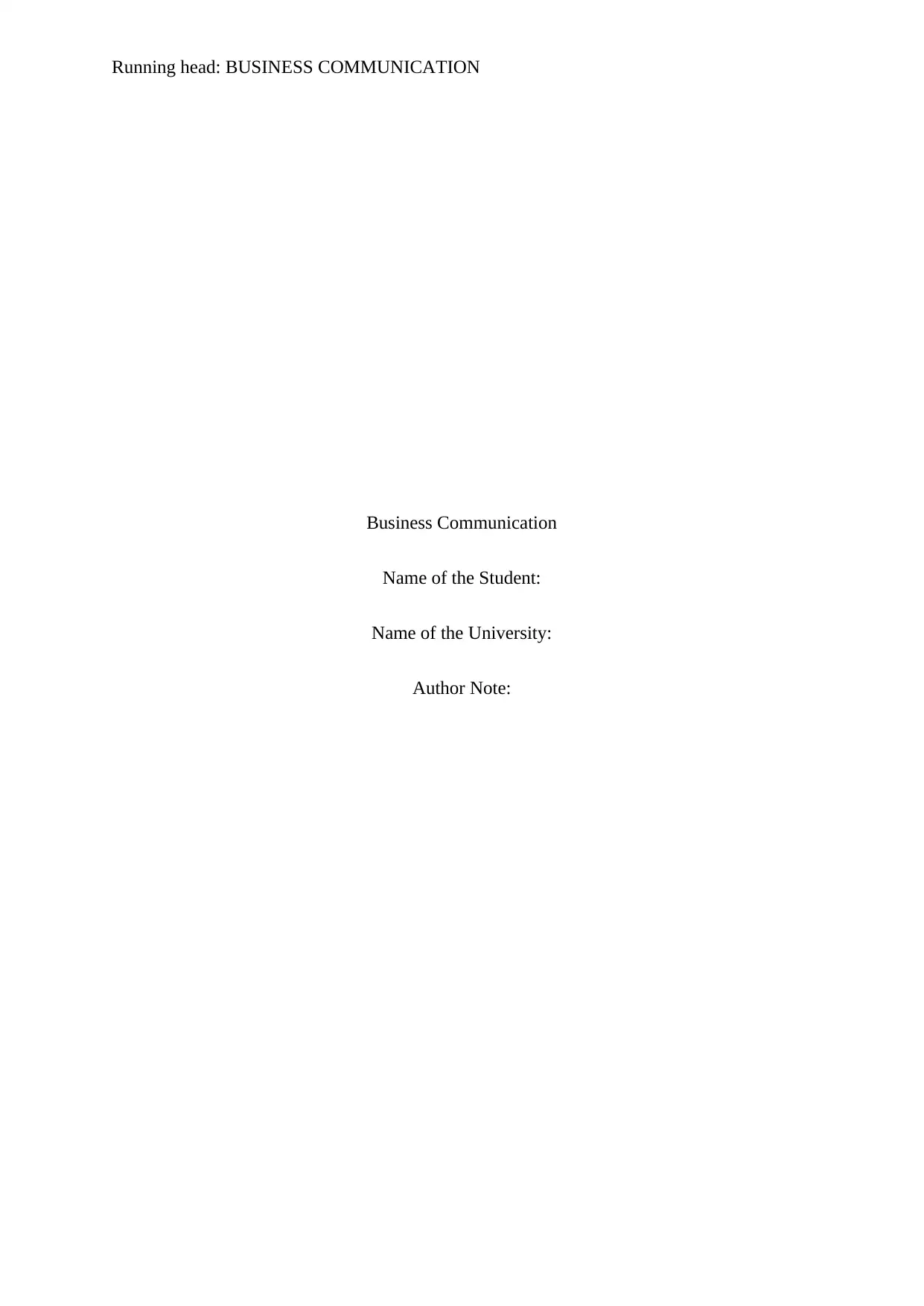
Running head: BUSINESS COMMUNICATION
Business Communication
Name of the Student:
Name of the University:
Author Note:
Business Communication
Name of the Student:
Name of the University:
Author Note:
Secure Best Marks with AI Grader
Need help grading? Try our AI Grader for instant feedback on your assignments.
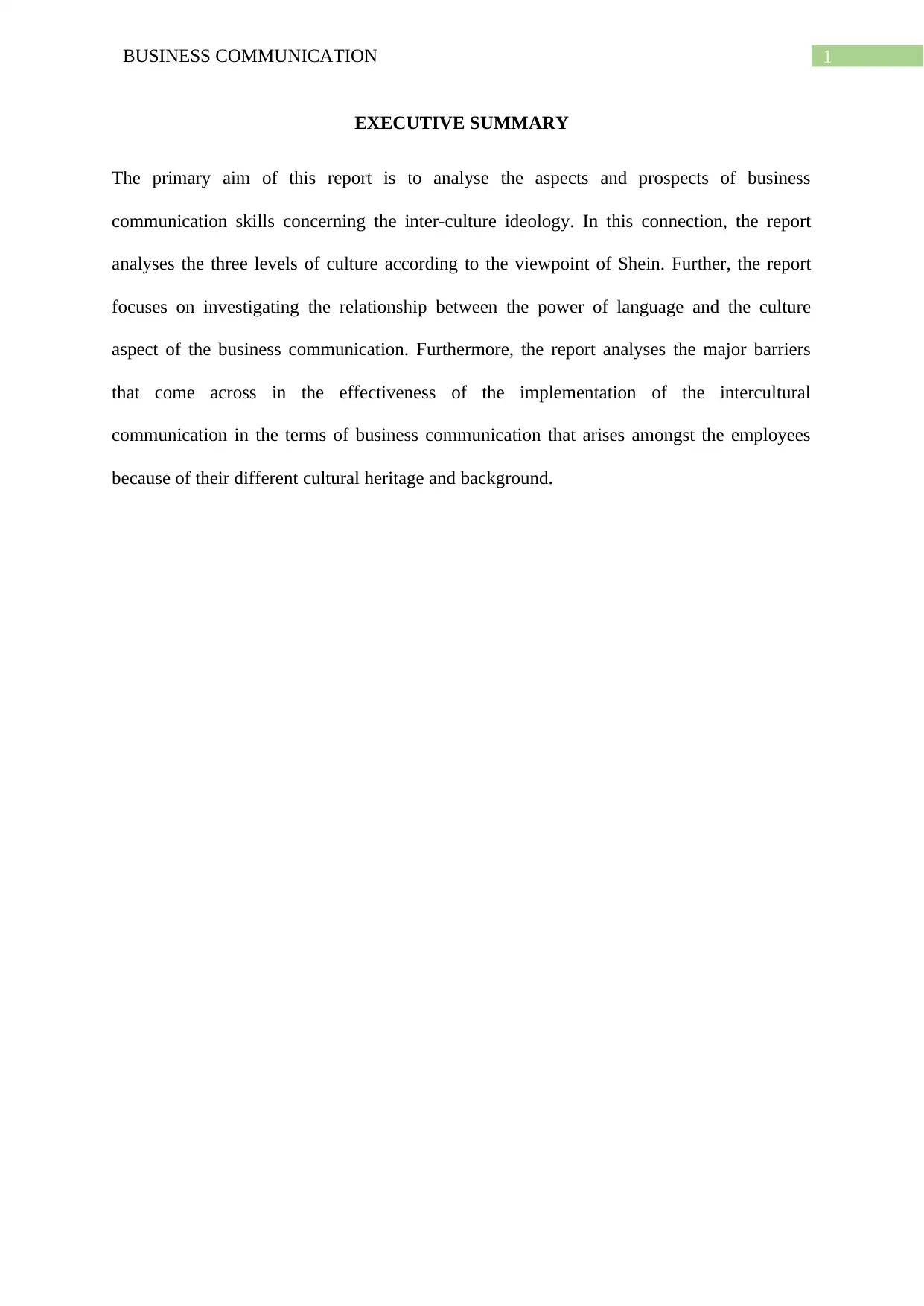
1BUSINESS COMMUNICATION
EXECUTIVE SUMMARY
The primary aim of this report is to analyse the aspects and prospects of business
communication skills concerning the inter-culture ideology. In this connection, the report
analyses the three levels of culture according to the viewpoint of Shein. Further, the report
focuses on investigating the relationship between the power of language and the culture
aspect of the business communication. Furthermore, the report analyses the major barriers
that come across in the effectiveness of the implementation of the intercultural
communication in the terms of business communication that arises amongst the employees
because of their different cultural heritage and background.
EXECUTIVE SUMMARY
The primary aim of this report is to analyse the aspects and prospects of business
communication skills concerning the inter-culture ideology. In this connection, the report
analyses the three levels of culture according to the viewpoint of Shein. Further, the report
focuses on investigating the relationship between the power of language and the culture
aspect of the business communication. Furthermore, the report analyses the major barriers
that come across in the effectiveness of the implementation of the intercultural
communication in the terms of business communication that arises amongst the employees
because of their different cultural heritage and background.
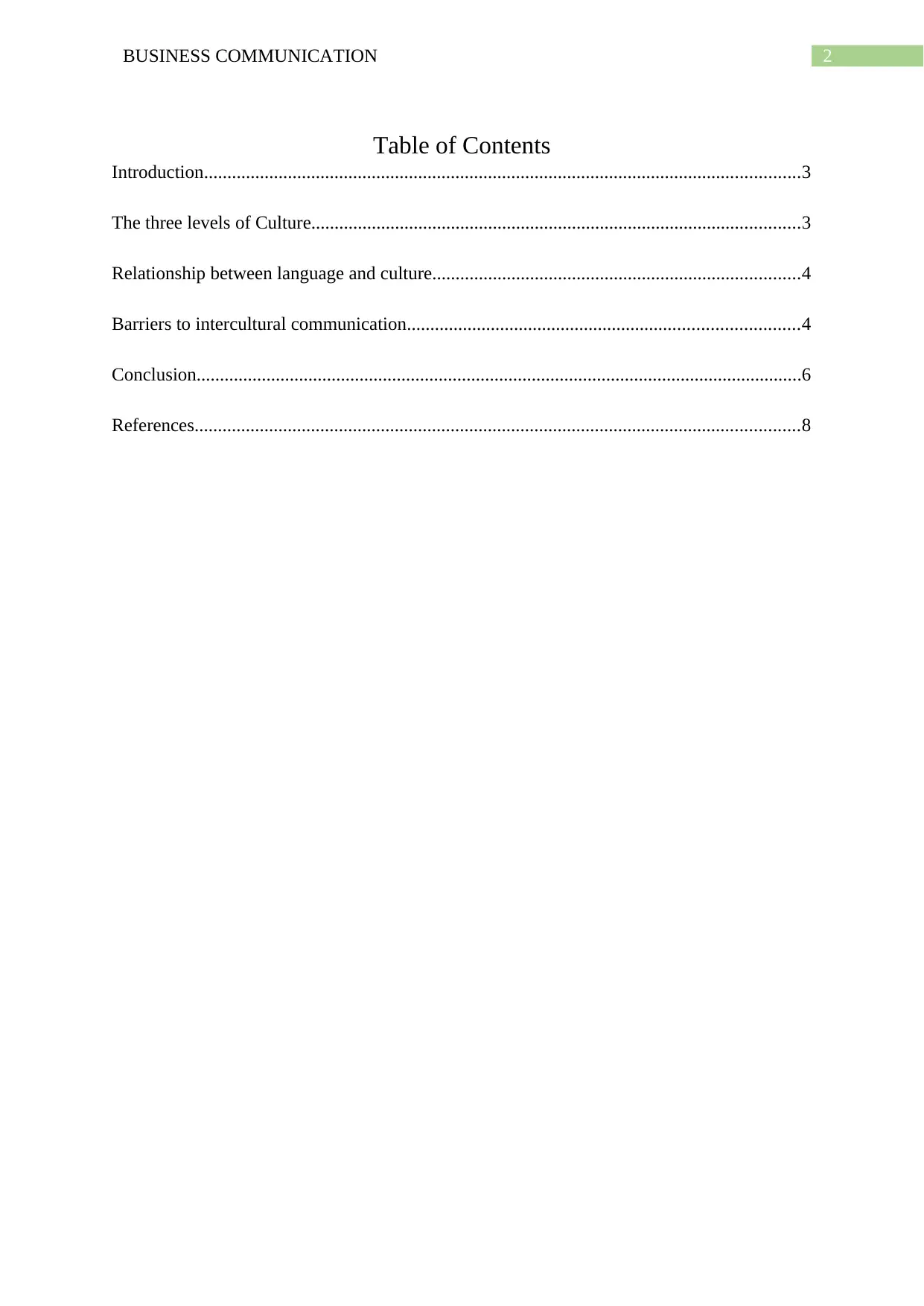
2BUSINESS COMMUNICATION
Table of Contents
Introduction................................................................................................................................3
The three levels of Culture.........................................................................................................3
Relationship between language and culture...............................................................................4
Barriers to intercultural communication....................................................................................4
Conclusion..................................................................................................................................6
References..................................................................................................................................8
Table of Contents
Introduction................................................................................................................................3
The three levels of Culture.........................................................................................................3
Relationship between language and culture...............................................................................4
Barriers to intercultural communication....................................................................................4
Conclusion..................................................................................................................................6
References..................................................................................................................................8
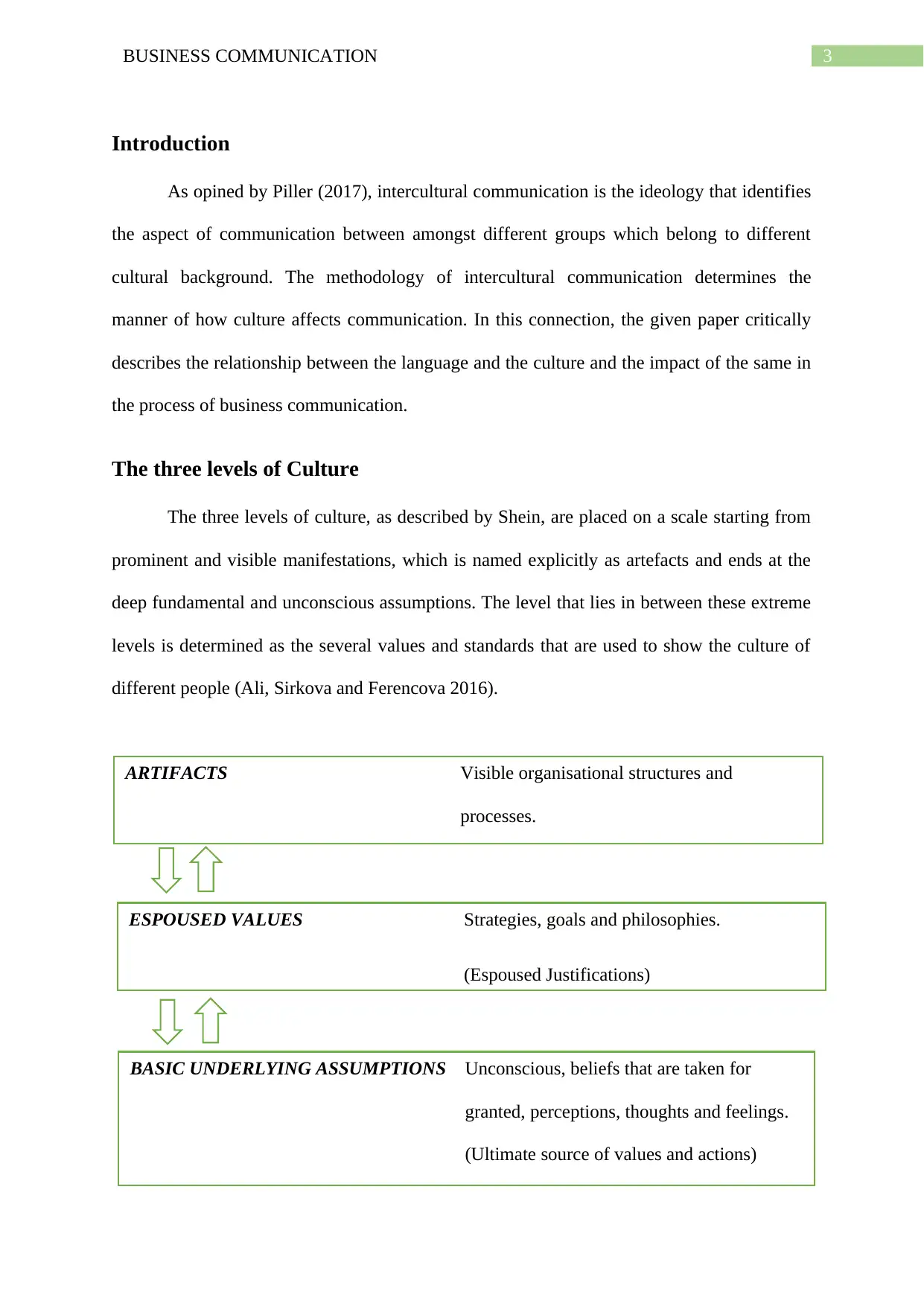
3BUSINESS COMMUNICATION
Introduction
As opined by Piller (2017), intercultural communication is the ideology that identifies
the aspect of communication between amongst different groups which belong to different
cultural background. The methodology of intercultural communication determines the
manner of how culture affects communication. In this connection, the given paper critically
describes the relationship between the language and the culture and the impact of the same in
the process of business communication.
The three levels of Culture
The three levels of culture, as described by Shein, are placed on a scale starting from
prominent and visible manifestations, which is named explicitly as artefacts and ends at the
deep fundamental and unconscious assumptions. The level that lies in between these extreme
levels is determined as the several values and standards that are used to show the culture of
different people (Ali, Sirkova and Ferencova 2016).
ARTIFACTS Visible organisational structures and
processes.
ESPOUSED VALUES Strategies, goals and philosophies.
(Espoused Justifications)
BASIC UNDERLYING ASSUMPTIONS Unconscious, beliefs that are taken for
granted, perceptions, thoughts and feelings.
(Ultimate source of values and actions)
Introduction
As opined by Piller (2017), intercultural communication is the ideology that identifies
the aspect of communication between amongst different groups which belong to different
cultural background. The methodology of intercultural communication determines the
manner of how culture affects communication. In this connection, the given paper critically
describes the relationship between the language and the culture and the impact of the same in
the process of business communication.
The three levels of Culture
The three levels of culture, as described by Shein, are placed on a scale starting from
prominent and visible manifestations, which is named explicitly as artefacts and ends at the
deep fundamental and unconscious assumptions. The level that lies in between these extreme
levels is determined as the several values and standards that are used to show the culture of
different people (Ali, Sirkova and Ferencova 2016).
ARTIFACTS Visible organisational structures and
processes.
ESPOUSED VALUES Strategies, goals and philosophies.
(Espoused Justifications)
BASIC UNDERLYING ASSUMPTIONS Unconscious, beliefs that are taken for
granted, perceptions, thoughts and feelings.
(Ultimate source of values and actions)
Secure Best Marks with AI Grader
Need help grading? Try our AI Grader for instant feedback on your assignments.
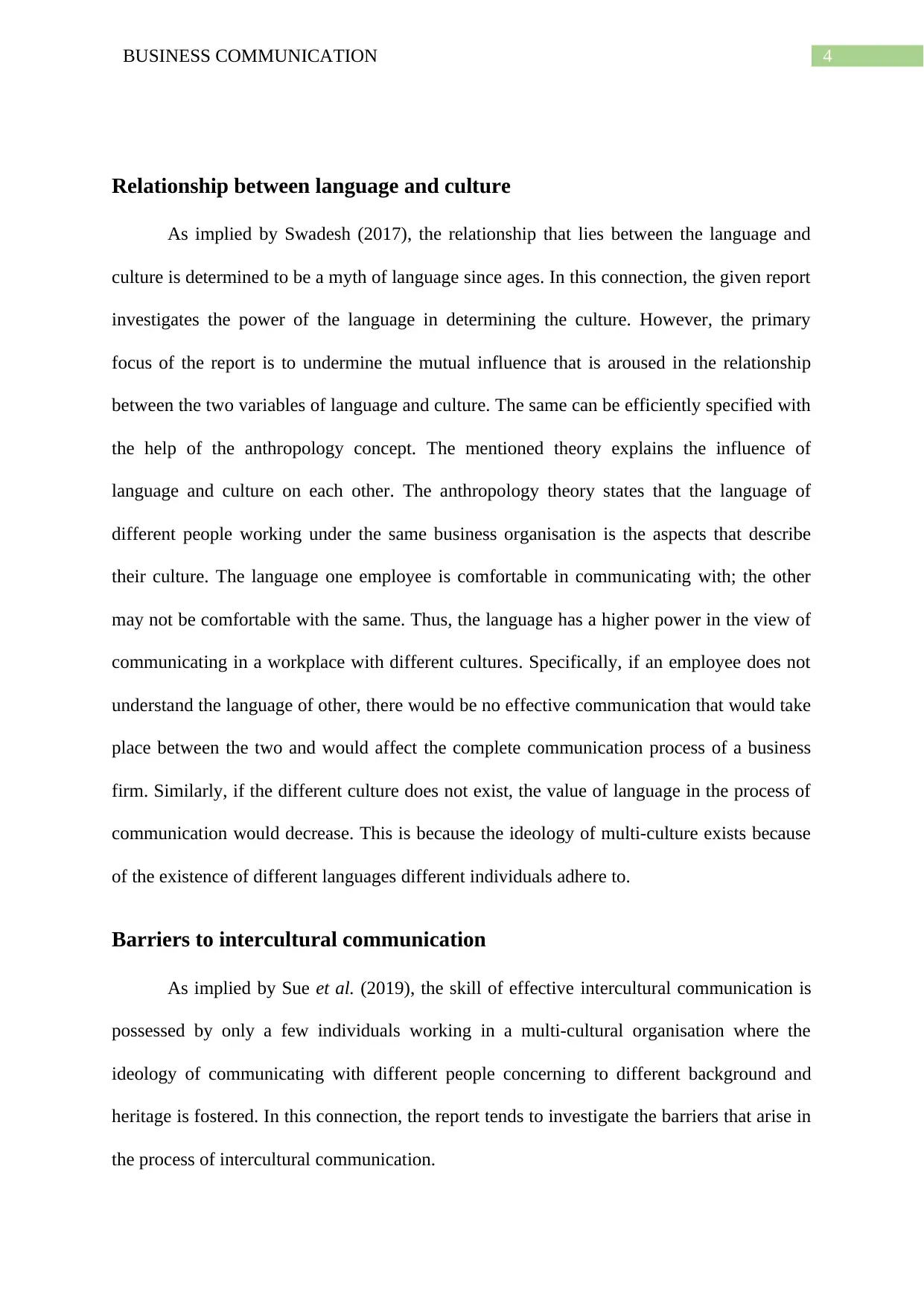
4BUSINESS COMMUNICATION
Relationship between language and culture
As implied by Swadesh (2017), the relationship that lies between the language and
culture is determined to be a myth of language since ages. In this connection, the given report
investigates the power of the language in determining the culture. However, the primary
focus of the report is to undermine the mutual influence that is aroused in the relationship
between the two variables of language and culture. The same can be efficiently specified with
the help of the anthropology concept. The mentioned theory explains the influence of
language and culture on each other. The anthropology theory states that the language of
different people working under the same business organisation is the aspects that describe
their culture. The language one employee is comfortable in communicating with; the other
may not be comfortable with the same. Thus, the language has a higher power in the view of
communicating in a workplace with different cultures. Specifically, if an employee does not
understand the language of other, there would be no effective communication that would take
place between the two and would affect the complete communication process of a business
firm. Similarly, if the different culture does not exist, the value of language in the process of
communication would decrease. This is because the ideology of multi-culture exists because
of the existence of different languages different individuals adhere to.
Barriers to intercultural communication
As implied by Sue et al. (2019), the skill of effective intercultural communication is
possessed by only a few individuals working in a multi-cultural organisation where the
ideology of communicating with different people concerning to different background and
heritage is fostered. In this connection, the report tends to investigate the barriers that arise in
the process of intercultural communication.
Relationship between language and culture
As implied by Swadesh (2017), the relationship that lies between the language and
culture is determined to be a myth of language since ages. In this connection, the given report
investigates the power of the language in determining the culture. However, the primary
focus of the report is to undermine the mutual influence that is aroused in the relationship
between the two variables of language and culture. The same can be efficiently specified with
the help of the anthropology concept. The mentioned theory explains the influence of
language and culture on each other. The anthropology theory states that the language of
different people working under the same business organisation is the aspects that describe
their culture. The language one employee is comfortable in communicating with; the other
may not be comfortable with the same. Thus, the language has a higher power in the view of
communicating in a workplace with different cultures. Specifically, if an employee does not
understand the language of other, there would be no effective communication that would take
place between the two and would affect the complete communication process of a business
firm. Similarly, if the different culture does not exist, the value of language in the process of
communication would decrease. This is because the ideology of multi-culture exists because
of the existence of different languages different individuals adhere to.
Barriers to intercultural communication
As implied by Sue et al. (2019), the skill of effective intercultural communication is
possessed by only a few individuals working in a multi-cultural organisation where the
ideology of communicating with different people concerning to different background and
heritage is fostered. In this connection, the report tends to investigate the barriers that arise in
the process of intercultural communication.

5BUSINESS COMMUNICATION
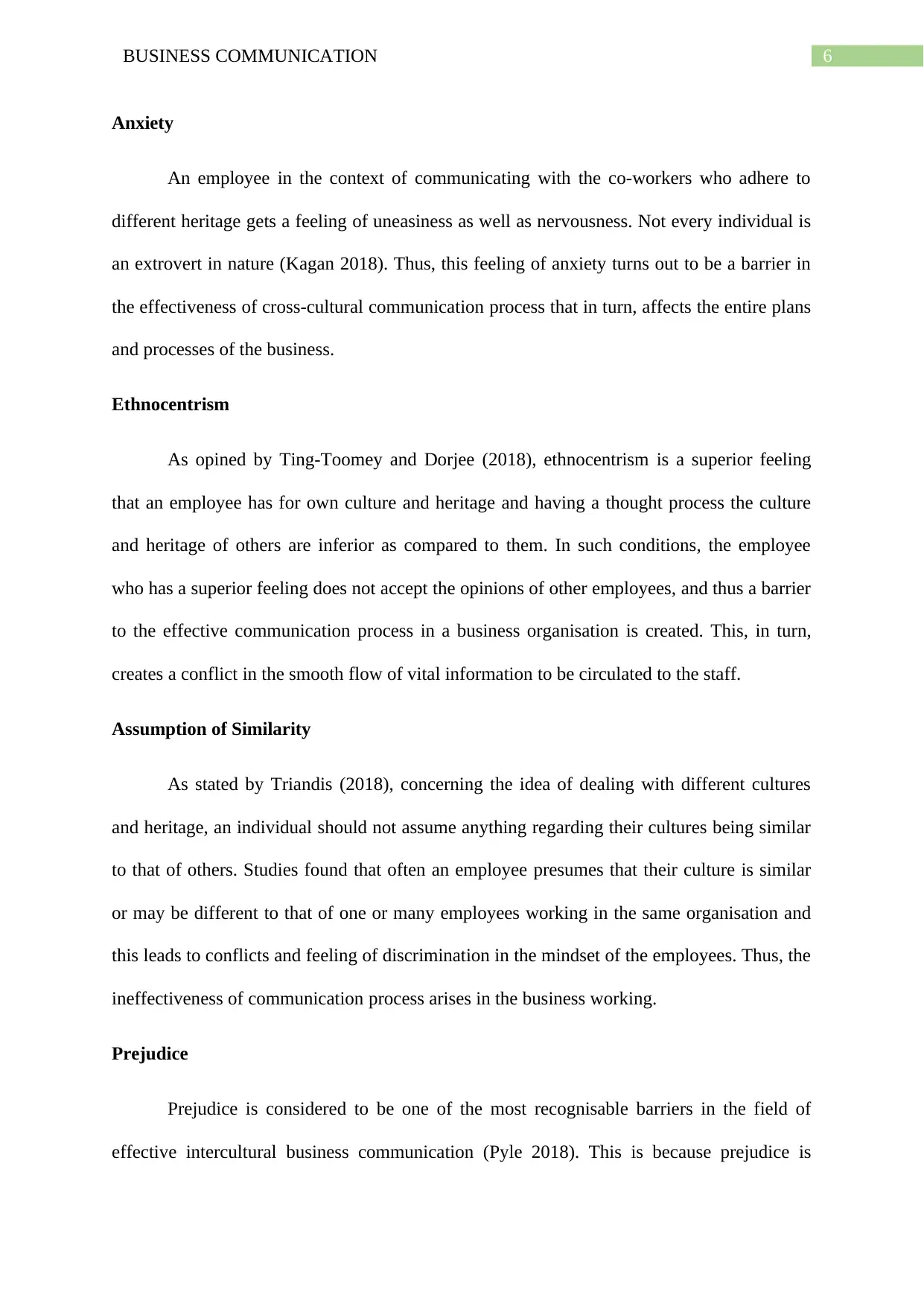
6BUSINESS COMMUNICATION
Anxiety
An employee in the context of communicating with the co-workers who adhere to
different heritage gets a feeling of uneasiness as well as nervousness. Not every individual is
an extrovert in nature (Kagan 2018). Thus, this feeling of anxiety turns out to be a barrier in
the effectiveness of cross-cultural communication process that in turn, affects the entire plans
and processes of the business.
Ethnocentrism
As opined by Ting-Toomey and Dorjee (2018), ethnocentrism is a superior feeling
that an employee has for own culture and heritage and having a thought process the culture
and heritage of others are inferior as compared to them. In such conditions, the employee
who has a superior feeling does not accept the opinions of other employees, and thus a barrier
to the effective communication process in a business organisation is created. This, in turn,
creates a conflict in the smooth flow of vital information to be circulated to the staff.
Assumption of Similarity
As stated by Triandis (2018), concerning the idea of dealing with different cultures
and heritage, an individual should not assume anything regarding their cultures being similar
to that of others. Studies found that often an employee presumes that their culture is similar
or may be different to that of one or many employees working in the same organisation and
this leads to conflicts and feeling of discrimination in the mindset of the employees. Thus, the
ineffectiveness of communication process arises in the business working.
Prejudice
Prejudice is considered to be one of the most recognisable barriers in the field of
effective intercultural business communication (Pyle 2018). This is because prejudice is
Anxiety
An employee in the context of communicating with the co-workers who adhere to
different heritage gets a feeling of uneasiness as well as nervousness. Not every individual is
an extrovert in nature (Kagan 2018). Thus, this feeling of anxiety turns out to be a barrier in
the effectiveness of cross-cultural communication process that in turn, affects the entire plans
and processes of the business.
Ethnocentrism
As opined by Ting-Toomey and Dorjee (2018), ethnocentrism is a superior feeling
that an employee has for own culture and heritage and having a thought process the culture
and heritage of others are inferior as compared to them. In such conditions, the employee
who has a superior feeling does not accept the opinions of other employees, and thus a barrier
to the effective communication process in a business organisation is created. This, in turn,
creates a conflict in the smooth flow of vital information to be circulated to the staff.
Assumption of Similarity
As stated by Triandis (2018), concerning the idea of dealing with different cultures
and heritage, an individual should not assume anything regarding their cultures being similar
to that of others. Studies found that often an employee presumes that their culture is similar
or may be different to that of one or many employees working in the same organisation and
this leads to conflicts and feeling of discrimination in the mindset of the employees. Thus, the
ineffectiveness of communication process arises in the business working.
Prejudice
Prejudice is considered to be one of the most recognisable barriers in the field of
effective intercultural business communication (Pyle 2018). This is because prejudice is
Paraphrase This Document
Need a fresh take? Get an instant paraphrase of this document with our AI Paraphraser
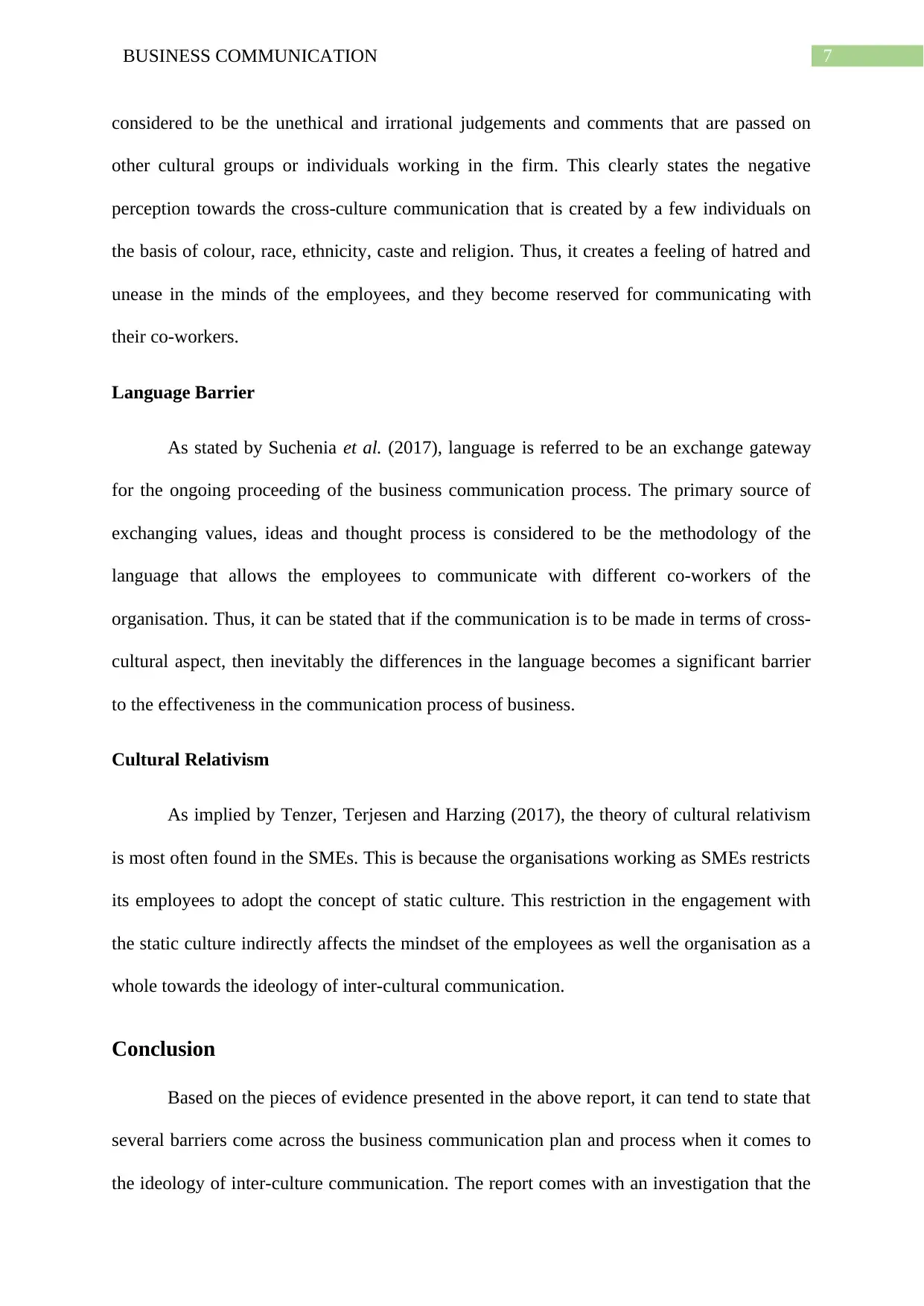
7BUSINESS COMMUNICATION
considered to be the unethical and irrational judgements and comments that are passed on
other cultural groups or individuals working in the firm. This clearly states the negative
perception towards the cross-culture communication that is created by a few individuals on
the basis of colour, race, ethnicity, caste and religion. Thus, it creates a feeling of hatred and
unease in the minds of the employees, and they become reserved for communicating with
their co-workers.
Language Barrier
As stated by Suchenia et al. (2017), language is referred to be an exchange gateway
for the ongoing proceeding of the business communication process. The primary source of
exchanging values, ideas and thought process is considered to be the methodology of the
language that allows the employees to communicate with different co-workers of the
organisation. Thus, it can be stated that if the communication is to be made in terms of cross-
cultural aspect, then inevitably the differences in the language becomes a significant barrier
to the effectiveness in the communication process of business.
Cultural Relativism
As implied by Tenzer, Terjesen and Harzing (2017), the theory of cultural relativism
is most often found in the SMEs. This is because the organisations working as SMEs restricts
its employees to adopt the concept of static culture. This restriction in the engagement with
the static culture indirectly affects the mindset of the employees as well the organisation as a
whole towards the ideology of inter-cultural communication.
Conclusion
Based on the pieces of evidence presented in the above report, it can tend to state that
several barriers come across the business communication plan and process when it comes to
the ideology of inter-culture communication. The report comes with an investigation that the
considered to be the unethical and irrational judgements and comments that are passed on
other cultural groups or individuals working in the firm. This clearly states the negative
perception towards the cross-culture communication that is created by a few individuals on
the basis of colour, race, ethnicity, caste and religion. Thus, it creates a feeling of hatred and
unease in the minds of the employees, and they become reserved for communicating with
their co-workers.
Language Barrier
As stated by Suchenia et al. (2017), language is referred to be an exchange gateway
for the ongoing proceeding of the business communication process. The primary source of
exchanging values, ideas and thought process is considered to be the methodology of the
language that allows the employees to communicate with different co-workers of the
organisation. Thus, it can be stated that if the communication is to be made in terms of cross-
cultural aspect, then inevitably the differences in the language becomes a significant barrier
to the effectiveness in the communication process of business.
Cultural Relativism
As implied by Tenzer, Terjesen and Harzing (2017), the theory of cultural relativism
is most often found in the SMEs. This is because the organisations working as SMEs restricts
its employees to adopt the concept of static culture. This restriction in the engagement with
the static culture indirectly affects the mindset of the employees as well the organisation as a
whole towards the ideology of inter-cultural communication.
Conclusion
Based on the pieces of evidence presented in the above report, it can tend to state that
several barriers come across the business communication plan and process when it comes to
the ideology of inter-culture communication. The report comes with an investigation that the
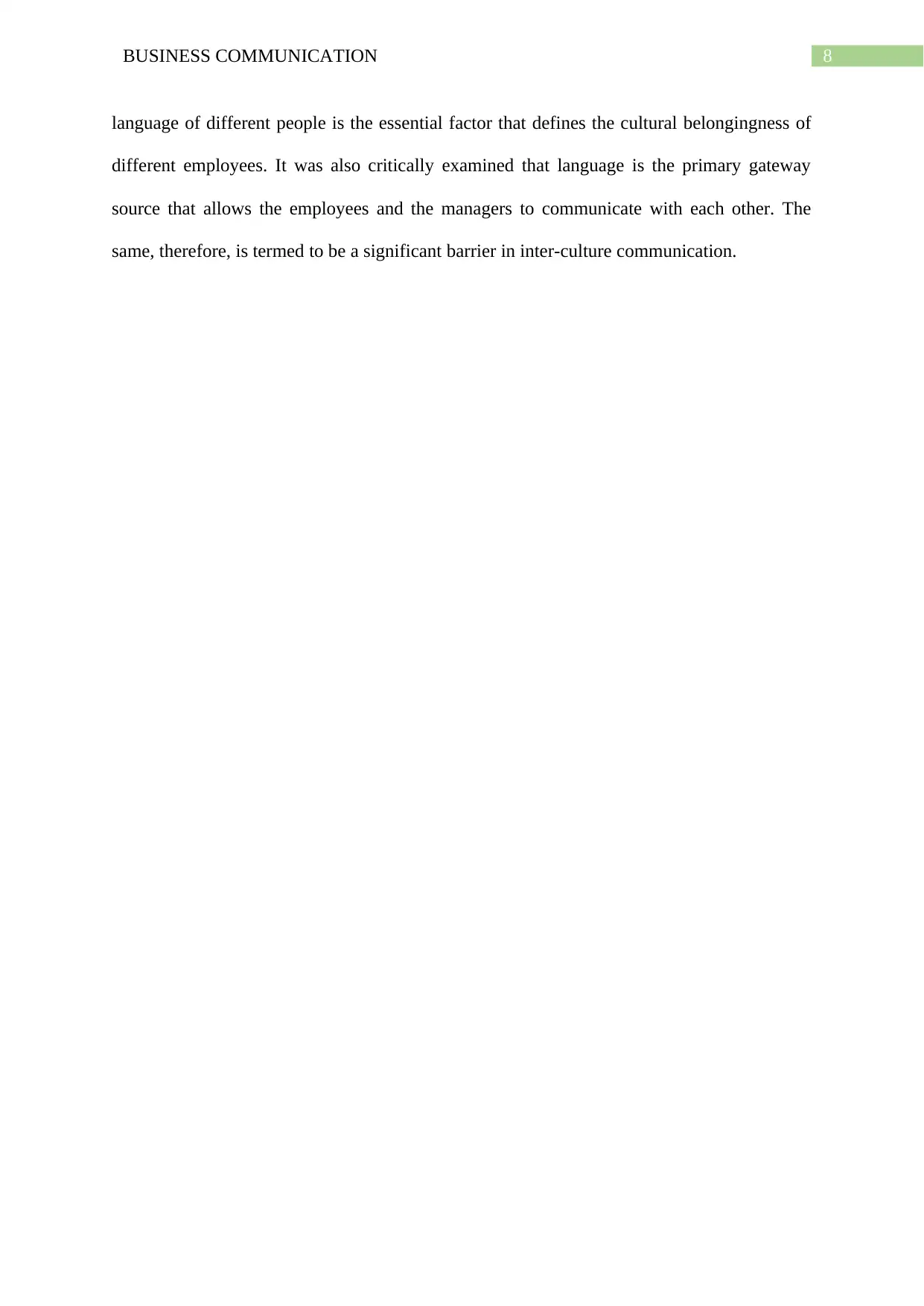
8BUSINESS COMMUNICATION
language of different people is the essential factor that defines the cultural belongingness of
different employees. It was also critically examined that language is the primary gateway
source that allows the employees and the managers to communicate with each other. The
same, therefore, is termed to be a significant barrier in inter-culture communication.
language of different people is the essential factor that defines the cultural belongingness of
different employees. It was also critically examined that language is the primary gateway
source that allows the employees and the managers to communicate with each other. The
same, therefore, is termed to be a significant barrier in inter-culture communication.
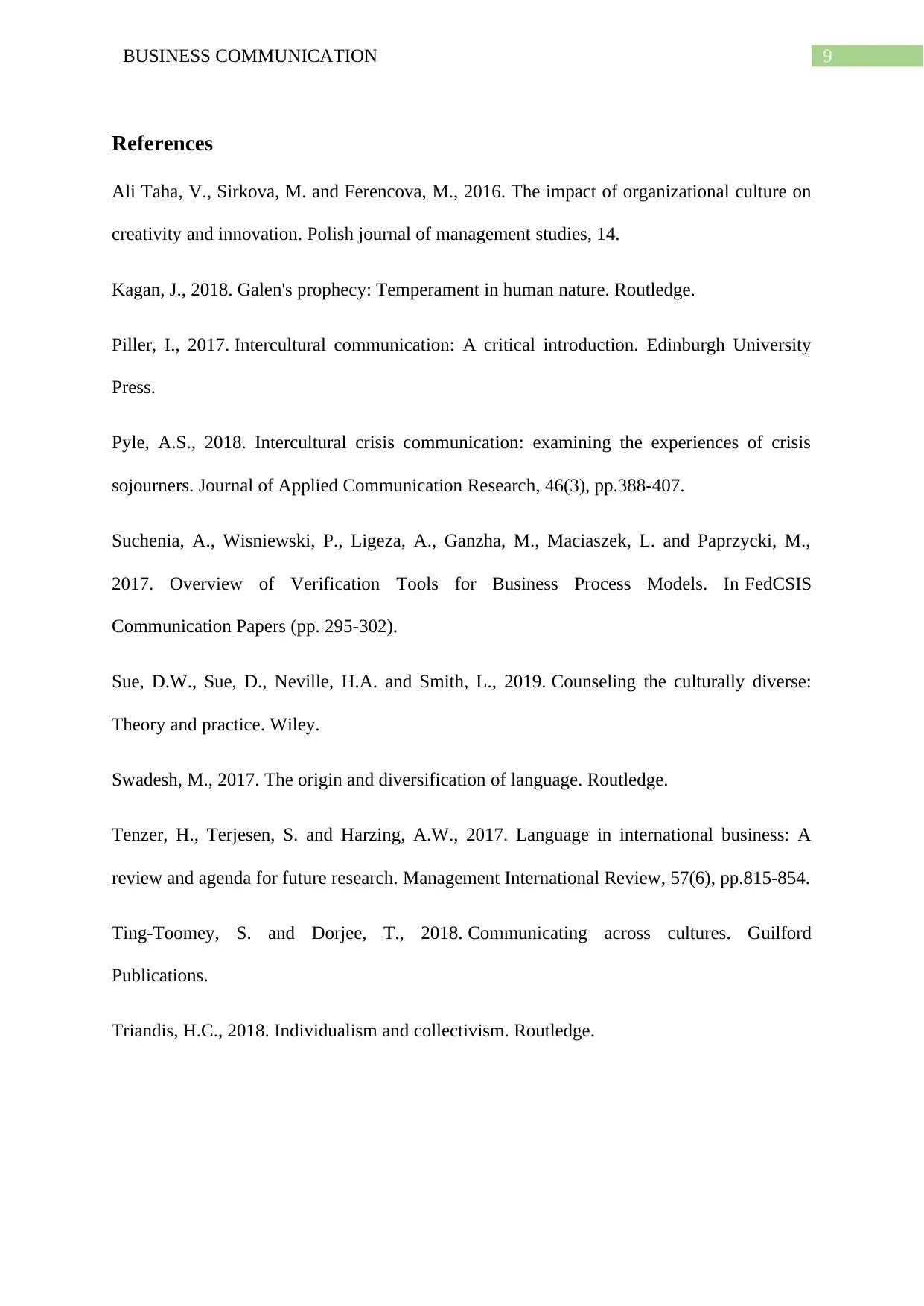
9BUSINESS COMMUNICATION
References
Ali Taha, V., Sirkova, M. and Ferencova, M., 2016. The impact of organizational culture on
creativity and innovation. Polish journal of management studies, 14.
Kagan, J., 2018. Galen's prophecy: Temperament in human nature. Routledge.
Piller, I., 2017. Intercultural communication: A critical introduction. Edinburgh University
Press.
Pyle, A.S., 2018. Intercultural crisis communication: examining the experiences of crisis
sojourners. Journal of Applied Communication Research, 46(3), pp.388-407.
Suchenia, A., Wisniewski, P., Ligeza, A., Ganzha, M., Maciaszek, L. and Paprzycki, M.,
2017. Overview of Verification Tools for Business Process Models. In FedCSIS
Communication Papers (pp. 295-302).
Sue, D.W., Sue, D., Neville, H.A. and Smith, L., 2019. Counseling the culturally diverse:
Theory and practice. Wiley.
Swadesh, M., 2017. The origin and diversification of language. Routledge.
Tenzer, H., Terjesen, S. and Harzing, A.W., 2017. Language in international business: A
review and agenda for future research. Management International Review, 57(6), pp.815-854.
Ting-Toomey, S. and Dorjee, T., 2018. Communicating across cultures. Guilford
Publications.
Triandis, H.C., 2018. Individualism and collectivism. Routledge.
References
Ali Taha, V., Sirkova, M. and Ferencova, M., 2016. The impact of organizational culture on
creativity and innovation. Polish journal of management studies, 14.
Kagan, J., 2018. Galen's prophecy: Temperament in human nature. Routledge.
Piller, I., 2017. Intercultural communication: A critical introduction. Edinburgh University
Press.
Pyle, A.S., 2018. Intercultural crisis communication: examining the experiences of crisis
sojourners. Journal of Applied Communication Research, 46(3), pp.388-407.
Suchenia, A., Wisniewski, P., Ligeza, A., Ganzha, M., Maciaszek, L. and Paprzycki, M.,
2017. Overview of Verification Tools for Business Process Models. In FedCSIS
Communication Papers (pp. 295-302).
Sue, D.W., Sue, D., Neville, H.A. and Smith, L., 2019. Counseling the culturally diverse:
Theory and practice. Wiley.
Swadesh, M., 2017. The origin and diversification of language. Routledge.
Tenzer, H., Terjesen, S. and Harzing, A.W., 2017. Language in international business: A
review and agenda for future research. Management International Review, 57(6), pp.815-854.
Ting-Toomey, S. and Dorjee, T., 2018. Communicating across cultures. Guilford
Publications.
Triandis, H.C., 2018. Individualism and collectivism. Routledge.
1 out of 10
Related Documents
Your All-in-One AI-Powered Toolkit for Academic Success.
+13062052269
info@desklib.com
Available 24*7 on WhatsApp / Email
![[object Object]](/_next/static/media/star-bottom.7253800d.svg)
Unlock your academic potential
© 2024 | Zucol Services PVT LTD | All rights reserved.





